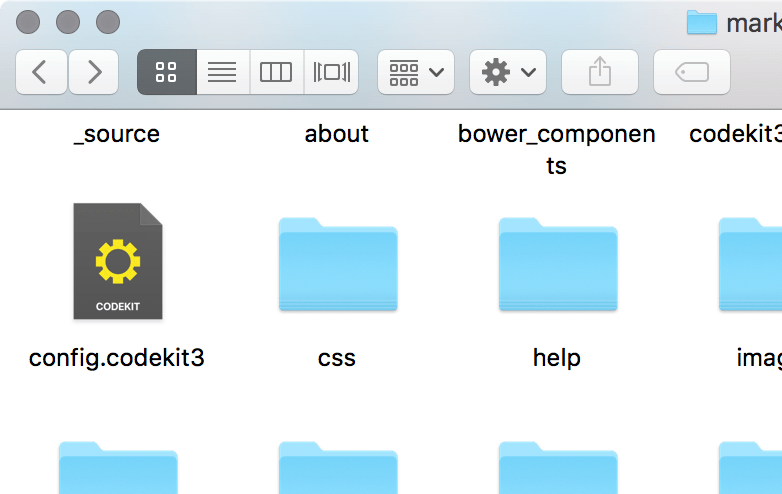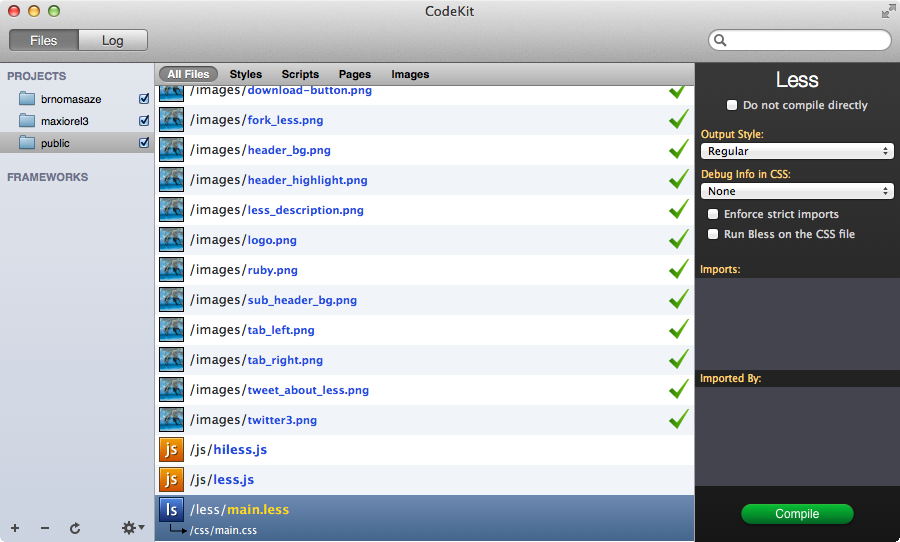

- Codekit setup sass version for mac#
- Codekit setup sass version install#
- Codekit setup sass version update#
- Codekit setup sass version code#
- Codekit setup sass version windows#
As we showed earlier, you can use the sass command to take a. We can also watch a file or folder for changes before generating the new. We can use task runners like Gulp or Grunt to manage or Sass or Less files. Task runners are usually JavaScript that handle various tasks for a web site platform including preprocessing Sass, checking for syntax issues, and concatenating/minifying. This method is very helpful and worth some time to learn about, but it’s out of scope for this course. Some integrated development environments (IDE) also are able to handle processing your Sass or Less files. Popular front-end IDEs include Visual Studio Code, Sublime Text, Atom, and WebStorm.
Codekit setup sass version code#
We will be using Visual Studio Code to access Node-Sass to process out. If using the command line is a bit overwhelming, you can roll the preprocessor into your workflow by using a simple GUI on your development machine and compile as you go. Several applications are available for Sass and Less. Some of those available applications are: CodeKitĬodeKit is a GUI interface for dealing with Sass and Less and currently is only available on the Mac.
Codekit setup sass version install#
Install CodeKit to avoid setting up preprocessing via the command line. It’s as simple as dragging the files you want to compile into CodeKit’s GUI. CodeKit watches those files, and recompiles every time you make a change.
Codekit setup sass version update#
Basically, every time you save your code and update the index.html file, CodeKit generates the CSS file and it automatically updates the browser. In addition to preprocessing, CodeKit includes script minification, image compression, and code hinting. Compass.appĬompass.app is a versatile multi-platform GUI that compiles Compass, which is a framework for Sass. Compass is a style sheet authoring framework that makes your style sheets and markup easier to build and maintain. With Compass, you write your style sheets in Sass instead of CSS, without having to use the command line. Compass.app is written in Java (JRuby), and works in Mac, Windows, and Linux. You do not need to install the Ruby environment first to use it. GhostLab is a Mac-based app that compiles Sass and tests responsive design across a variety of devices and browsers. It supports Sass and Less, tracking changes to local files and refreshing them on all connected clients. GhostLab has two modes of synchronizing which page to load and when, automatically loading the most recent HTML content with one-click synchronization.
Codekit setup sass version for mac#
Hammer is a web development tool for Mac that automatically compiles Sass to HTML, CSS, and JavaScript. Remember this npm script runs Webpack in watch mode and will watch for any changes in your Sass files and output the processed CSS file.In addition, Hammer builds, previews, and publishes static HTML sites and templates. Right click dev -> Bindings -> Project Open - Visual Studio will run this task when you open the project.Remember this npm script runs Webpack for production and will optimize the CSS file. Right click build -> Bindings -> Before Build - Visual Studio will run this task before each build.You will also see some tasks under Defaults, but you can just ignore them. The window will show at the bottom and you will see the scripts you created in package.json listed there under Custom.
Codekit setup sass version windows#
Navigate to View -> Other Windows -> Task Runner Explorer. Now we need to create some bindings in Task Runner Explorer. Refer to the comments in the code to understand the configuration. Open this new Sass file and copy the following: /* Please see documentation at \ for details on configuring this project to bundle and minify static web assets. Inside it, create a Sass file and name it site.scss. I’m naming my project netcore-sass-webpack.Ĭreate a Styles folder within the root of the project. Open Visual Studio and create a new ASP.NET Core Web Application, then select Web Application (Model-View-Controller). You would just need to modify the Webpack configuration a little bit to output the CSS file to the Content directory. NET Core MVC app, but the same principles apply to any ASP.NET MVC app. You’ll also need npm, but it will also be installed with Node. You will need to have Node installed, and you can grab it here. Also, vendor prefixes will be added automatically to your CSS rules. This is the case with one of the most popular compiler plug-ins on the market.īy configuring the compilation yourself, you will have total control over the output.

But what happens if the plug-in is not supported anymore and stops working with newer Visual Studio versions? Well, too bad. Sure, there are some plug-ins in the Visual Studio Marketplace, and it can be nice to just install a plug-in and forget about configuration.


 0 kommentar(er)
0 kommentar(er)
